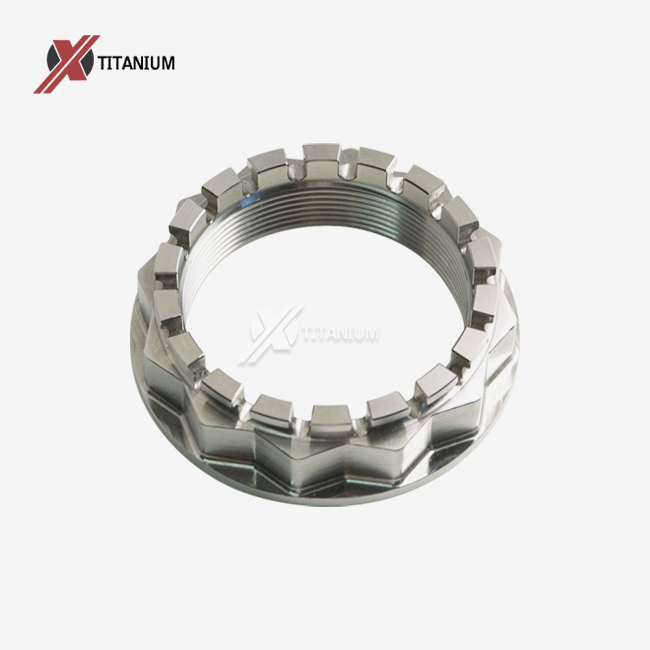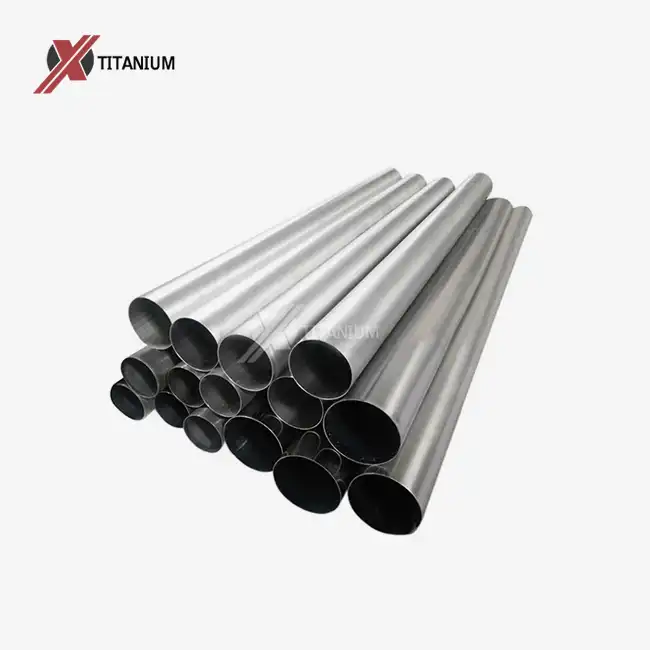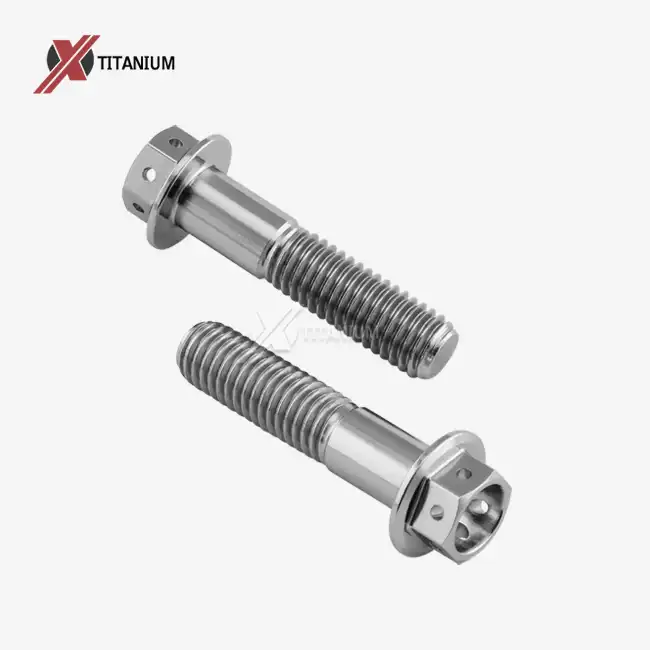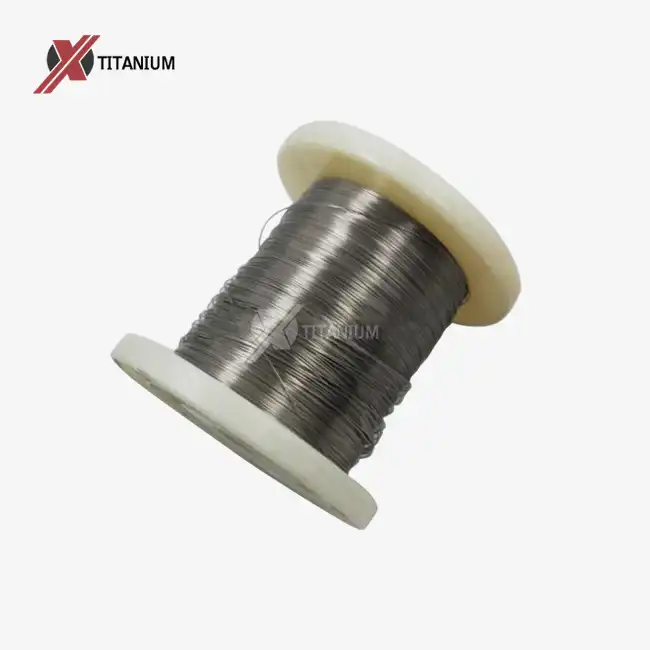The Science Behind Titanium Axle Nuts
Material Properties of Titanium
Titanium, the miracle metal of the motorsports world, boasts an impressive array of properties that make it ideal for axle nuts. With a density of just 4.5 g/cm³, titanium is approximately 45% lighter than steel, yet it maintains comparable strength. This extraordinary strength-to-weight ratio is the cornerstone of titanium's appeal in high-performance applications.
The atomic structure of titanium contributes to its remarkable characteristics. Its hexagonal close-packed crystal structure imparts excellent fatigue resistance, crucial for components subjected to repeated stress cycles. Furthermore, titanium forms a passive oxide layer when exposed to air, rendering it highly resistant to corrosion and chemical attack. This self-healing property ensures that titanium axle nuts maintain their integrity even in challenging environments.
Manufacturing Process
The production of titanium axle nuts is a sophisticated process that demands precision and expertise. It typically begins with the selection of high-grade titanium alloy, often Ti-6Al-4V (Grade 5), known for its superior mechanical properties. The manufacturing journey involves several key stages:
- Forging: The titanium is heated and shaped under high pressure to enhance its strength and grain structure.
- CNC Machining: Computer-controlled lathes and mills shape the forged titanium into precise nut geometries.
- Thread Cutting: High-precision tools cut the internal threads to exact specifications.
- Heat Treatment: The nuts undergo carefully controlled heating and cooling cycles to optimize their mechanical properties.
- Surface Treatment: Processes like anodizing or nitriding may be applied to further enhance durability and aesthetics.
Quality control measures are implemented at each stage to ensure the final product meets or exceeds industry standards such as ASTM B348 and ISO 5832-3.
Performance Benefits of Titanium Axle Nuts
Weight Reduction and Its Impact
The adoption of titanium axle nuts yields a significant weight reduction compared to traditional steel components. While the absolute weight difference may seem modest—often just a few grams per nut—the impact on performance is disproportionately large due to the principle of rotational mass.
Rotational mass, particularly at the wheel ends, has a magnified effect on a motorcycle's dynamics. By reducing this mass, titanium axle nuts contribute to:
- Quicker acceleration and deceleration
- Improved suspension response
- Enhanced cornering agility
- Reduced gyroscopic effects, facilitating easier direction changes
These improvements are especially noticeable in racing scenarios where fractions of a second can make the difference between victory and defeat.
Durability and Longevity
While the performance benefits of titanium axle nuts are compelling, their durability is equally impressive. The inherent properties of titanium translate into exceptional longevity for these critical components:
- Corrosion Resistance: Titanium's natural oxide layer protects against rust and degradation, even in salt-spray environments.
- Fatigue Strength: The high fatigue limit of titanium ensures the nuts can withstand millions of stress cycles without failure.
- Temperature Stability: Titanium maintains its properties across a wide temperature range, from cryogenic to elevated temperatures.
- Galling Resistance: Unlike some metals, titanium is resistant to galling, reducing the risk of seized nuts during maintenance.
These durability features not only enhance safety but also contribute to reduced maintenance costs over the long term. Riders can enjoy peace of mind knowing their titanium axle nuts will perform reliably under diverse and demanding conditions.
Choosing the Right Titanium Axle Nuts
Compatibility and Fitment
Selecting the appropriate titanium axle nuts is crucial for optimal performance and safety. Compatibility considerations include:
- Thread Size and Pitch: Ensure exact matching with your motorcycle's axle specifications.
- Nut Type: Choose between hexagonal, flanged, or lock nut designs based on your application.
- Torque Specifications: Adhere to manufacturer-recommended torque values for proper installation.
- Washers and Spacers: Use compatible titanium or aluminum components to maintain the weight advantage.
It's imperative to consult your motorcycle's manual or a qualified technician to confirm the correct specifications before purchase.
Aesthetic Considerations
Beyond their functional benefits, titanium axle nuts offer aesthetic appeal that can enhance the visual impact of your motorcycle. Options include:
- Natural Titanium Finish: A subtle, industrial look that exudes quality.
- Anodized Colors: Available in black, gold, blue, purple, and even rainbow finishes to complement your bike's color scheme.
- Custom Engraving: Some manufacturers offer personalized engraving for a unique touch.
While aesthetics shouldn't override performance considerations, the ability to customize the appearance of these components allows riders to express their personal style.
Installation and Maintenance Tips
Proper installation and maintenance of titanium axle nuts are essential for realizing their full benefits:
- Use a calibrated torque wrench to achieve the correct tightening specification.
- Apply a small amount of anti-seize compound to prevent galling, but avoid over-application.
- Regularly inspect the nuts for any signs of wear or damage.
- Clean with mild soap and water; avoid harsh chemicals that could damage the protective oxide layer.
- Re-torque after the first ride and periodically thereafter, following manufacturer guidelines.
Conclusion
Titanium axle nuts represent a pinnacle of motorcycle component engineering, offering a compelling blend of weight reduction, strength, and durability. Their adoption can lead to tangible improvements in a motorcycle's speed, agility, and overall performance. While the initial investment may be higher than traditional steel components, the long-term benefits in terms of performance gains and longevity make them a worthy consideration for serious riders and racers alike.
As the motorsports industry continues to push the boundaries of performance, components like titanium axle nuts play a crucial role in achieving marginal gains that can make a significant difference. Whether you're a professional racer seeking every possible advantage or an enthusiast looking to upgrade your ride, titanium axle nuts offer a sophisticated solution to enhance your motorcycle's capabilities.
For more information on titanium axle nuts and other high-performance titanium components, please contact us at info@cltifastener.com or djy6580@aliyun.com. Our team of experts is ready to help you find the perfect titanium solutions for your specific needs.




